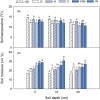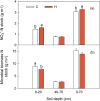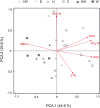Precipitation overrides warming in mediating soil nitrogen pools in an alpine grassland ecosystem on the Tibetan Plateau
- PMID: 27527683
- PMCID: PMC4985624
- DOI: 10.1038/srep31438
Precipitation overrides warming in mediating soil nitrogen pools in an alpine grassland ecosystem on the Tibetan Plateau
Abstract
Soils in the alpine grassland store a large amount of nitrogen (N) due to slow decomposition. However, the decomposition could be affected by climate change, which has profound impacts on soil N cycling. We investigated the changes of soil total N and five labile N stocks in the topsoil, the subsoil and the entire soil profile in response to three years of experimental warming and altered precipitation in a Tibetan alpine grassland. We found that warming significantly increased soil nitrate N stock and decreased microbial biomass N (MBN) stock. Increased precipitation reduced nitrate N, dissolved organic N and amino acid N stocks, but increased MBN stock in the topsoil. No change in soil total N was detected under warming and altered precipitation regimes. Redundancy analysis further revealed that soil moisture (26.3%) overrode soil temperature (10.4%) in explaining the variations of soil N stocks across the treatments. Our results suggest that precipitation exerted stronger influence than warming on soil N pools in this mesic and high-elevation grassland ecosystem. This indicates that the projected rise in future precipitation may lead to a significant loss of dissolved soil N pools by stimulating the biogeochemical processes in this alpine grassland.
Figures





References
-
- Zhang W. et al.. Soil microbial responses to experimental warming and clipping in a tallgrass prairie. Global Change Biol. 11, 266–277 (2005).
-
- Rustad L. E. et al.. A meta-analysis of the response of soil respiration, net nitrogen mineralization, and aboveground plant growth to experimental ecosystem warming. Oecologia 126, 543–562 (2001). - PubMed
-
- Belay-Tedla A., Zhou X. H., Su B., Wan S. Q. & Luo Y. Q. Labile, recalcitrant, and microbial carbon and nitrogen pools of a tallgrass prairie soil in the US Great Plains subjected to experimental warming and clipping. Soil Biol. Biochem. 41, 110–116 (2009).
-
- Xu Z. H. & Chen C. R. Fingerprinting global climate change and forest management within rhizosphere carbon and nutrient cycling processes. Environ. Sci. Pollut. R. 13, 293–298 (2006). - PubMed
Publication types
MeSH terms
Substances
LinkOut - more resources
Full Text Sources
Other Literature Sources
Miscellaneous

